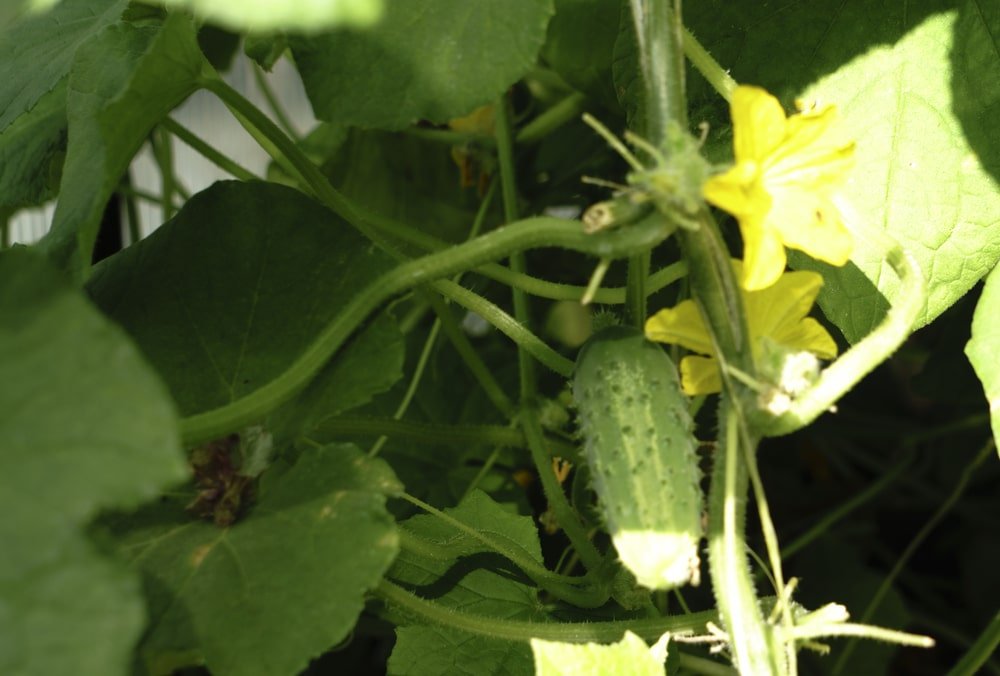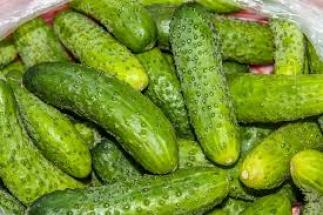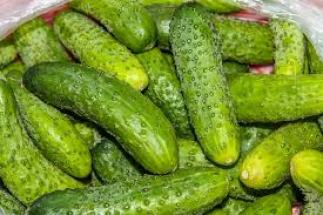Have you ever wondered why cucumbers have spiky skin? It turns out that those little spikes are not just for decoration – they actually serve a very important purpose. The spiky skin of cucumbers is a natural defense mechanism that helps protect the fruit from potential predators. These spikes, also known as trichomes, provide a layer of protection against insects and other animals that might try to nibble on the cucumber. So next time you’re enjoying a crisp cucumber, remember that its spiky skin is there to thank for keeping it safe and delicious.

What Causes Cucumbers to Have Spiky Skin?
Cucumbers, those refreshing and hydrating vegetables we love to include in our salads and sandwiches, often catch our attention with their unique spiky skin. But have you ever wondered why cucumbers have spiky skin? In this article, we will explore the fascinating reasons behind this intriguing trait, covering everything from nature’s defense mechanisms to the impact of environmental factors. So, let’s dive in and unearth the secrets of cucumber spikiness!
Nature’s Defense Mechanism
Evolutionary Adaptation
One of the primary reasons why cucumbers have spiky skin is due to their evolutionary adaptation. In the wild, where cucumbers originate from, spiky skin serves as a natural defense mechanism against predators. The spikes act as a deterrent, making it difficult for herbivores to consume the cucumber’s flesh and increasing its chances of survival.
Threats from Predators
By developing spiky skin, cucumbers have evolved an effective defense strategy against herbivores such as insects, birds, and mammals. The spines on the cucumber’s skin act as a physical barrier, deterring potential predators from taking a bite. This not only protects the cucumber plant but also ensures the viability of its seeds for future generations.
Microbial Protection
Apart from fending off predators, spiky skin also plays a crucial role in protecting cucumbers from microbial invasion. The natural bumps and spikes on the skin create a barrier that reduces the chances of pathogens and harmful microbes from infiltrating the cucumber’s flesh. This microbial protection helps maintain the cucumber’s freshness and extends its shelf life.

Varieties and Genetics
Traditional Breeding
Over centuries, humans have played a significant role in shaping the characteristics of various plant species, including cucumbers. Through traditional breeding techniques, breeders have selectively propagated cucumber varieties with spiky skin. This controlled breeding ensures that the desirable trait of spikiness is passed down to subsequent generations.
Genetic Mutation
Genetic mutations can also contribute to the formation of spiky skin in cucumbers. Sometimes, natural variations occur in the DNA of cucumber plants, leading to the development of spikes on their skin. Through a process of natural selection, these mutated individuals with spiky skin may thrive and pass on their genetic traits to future generations.
Hybridization
Hybridization, another technique used in modern plant breeding, has also played a role in the development of spiky-skinned cucumber varieties. By cross-breeding different types of cucumbers with varying skin textures, breeders can create hybrids with unique characteristics, including spiky skin. This method allows for the precise manipulation of traits, resulting in cucumbers with specific appearances.
Environmental Factors
Temperature and Moisture
Environmental factors, such as temperature and moisture, have a significant impact on the development of cucumber skin texture. Cucumbers grown in warmer climates tend to have smoother skin, while those cultivated in cooler regions or subjected to temperature fluctuations during growth may develop spikier skin. Additionally, adequate moisture levels are crucial for maintaining healthy skin texture.
Soil Conditions
The composition and fertility of the soil in which cucumbers are grown can also influence the development of spiky skin. Soil rich in essential nutrients and minerals supports optimal growth and development, resulting in healthier plants with smoother skin. Conversely, nutrient deficiencies or imbalances in the soil can contribute to the formation of spiky skin in cucumbers.
Sunlight Exposure
Exposure to sunlight is an essential environmental factor that can affect the texture of cucumber skin. Cucumbers grown in areas with ample sunlight exposure may have smoother skin, while those that receive less sunlight or are shaded by other plants may develop spikier skin. This is because sunlight plays a vital role in the production of certain compounds in cucumbers that contribute to skin texture.

Impact of Environmental Factors on Cucumber Skin
Now that we understand how environmental factors can influence cucumber skin texture, let’s take a closer look at the specific ways in which temperature, moisture, soil conditions, and sunlight exposure impact the development of spiky skin.
1. Temperature and Moisture
Cucumbers thrive in warmer temperatures, and an optimal balance of temperature and moisture is required for optimal growth. When cucumbers experience temperature fluctuations or inconsistent moisture levels during their development, it can result in the formation of spiky skin. This is thought to be a protective response, ensuring the survival of the plant under less favorable conditions.
2. Soil Conditions
The nutrient content and pH balance of the soil significantly affect the overall health and appearance of cucumbers, including their skin texture. When cucumbers are grown in nutrient-deficient soil or soil with imbalanced pH levels, it can lead to the formation of spiky skin. Providing cucumbers with well-balanced soil conditions promotes smoother skin texture.
3. Sunlight Exposure
Sunlight is essential for photosynthesis, which is the process by which plants convert sunlight into energy. Adequate sunlight exposure promotes optimal growth and development in cucumbers, including the development of smooth skin. When cucumbers receive insufficient sunlight or are shaded by surrounding plants, it can result in the formation of spiky skin as a response to suboptimal photosynthesis.
Commercial Importance of Cucumber Spikiness
Aesthetic Appeal
The spiky skin on cucumbers adds an appealing aesthetic touch to their appearance. Many consumers are attracted to the unique texture and visual appeal that the spikes bring, making spiky-skinned cucumbers a popular choice in the market. The distinctive look of these cucumbers can make them stand out among other smooth-skinned varieties.
Improved Shelf Life
The natural bumps and spikes on the skin of cucumbers also contribute to their improved shelf life. The spiky texture provides a protective barrier against physical damage, preventing bruising and crushing during transportation and storage. As a result, spikier cucumbers can often remain fresh and retain their quality for a longer period.
Reduced Pesticide Use
Another advantage of spiky-skinned cucumbers is their potential to reduce pesticide use. The spikes on the cucumber skin act as a deterrent to pests, reducing the likelihood of infestation. This natural defense mechanism may decrease the need for harmful chemical pesticides, offering a more sustainable and environmentally-friendly approach to cucumber cultivation.

Cucumber Varieties with Smooth Skin
While spiky-skinned cucumbers are popular and widely recognized, it’s essential to mention that there are varieties with smooth skin available as well. Let’s explore some of the cucumber varieties known for their smooth skin texture.
1. English Cucumbers
English cucumbers, also known as burpless or seedless cucumbers, are known for their long and slender shape. They have smooth and thin skin, providing a crisp and refreshing eating experience without the spikiness. English cucumbers are often favored for their mild flavor and reduced bitterness.
2. Burpless Cucumbers
Burpless cucumbers, as the name suggests, are known for being easy to digest and causing minimal gastric discomfort. These cucumbers typically have smooth skin, making them a popular choice for those who prefer a less pronounced skin texture.
3. Armenian Cucumbers
Armenian cucumbers, also referred to as snake melons, are a unique cucumber variety with a long and twisted shape. They have smooth skin and are known for their crunchy texture and mild flavor. Armenian cucumbers are often used in salads, pickling, and various culinary preparations.
Cucumbers versus Other Spiky Fruits and Vegetables
Cucumbers are not the only fruits and vegetables that can exhibit spiky characteristics. Let’s explore a few other examples of spiky produce and how they differ from cucumbers.
1. Prickly Lettuce
Prickly lettuce, also known as wild lettuce, is a leafy green plant with spiky leaves and stems. Unlike cucumbers, the spiky texture of prickly lettuce is not confined to the outer skin but encompasses the entire plant. The spikes on prickly lettuce serve as a deterrent to herbivores, protecting the plant’s valuable foliage.
2. Sea Cucumbers
Sea cucumbers are marine animals with cylindrical bodies covered in an array of spikes. Although they share a name with cucumbers, sea cucumbers are not botanically related to the vegetable. The spiky appearance of sea cucumbers serves a protective purpose, deterring potential predators and contributing to their survival in oceanic ecosystems.
3. Hedgehog Cactus
Hedgehog cacti, a type of desert cactus, feature a dense covering of spines on their exterior. While their spikiness serves to deter predators and reduce water loss through transpiration, hedgehog cacti differ significantly from cucumbers in terms of plant classification and usage.

Culinary Uses for Cucumbers and Their Skin
Cucumbers, with their refreshing flavor and crisp texture, have long been a favorite ingredient in various culinary creations. Both the flesh and the skin of cucumbers offer a range of delicious possibilities. Let’s explore some common culinary uses for cucumbers and their versatile skin.
Pickling
Cucumbers, especially those with spiky skin, are a popular choice for pickling. The bumps and spikes on the skin create unique textures and enhance the absorption of pickling brines, resulting in flavorful and crunchy pickled cucumbers. Whether you prefer sweet, tangy, or spicy, pickled cucumbers can be a delightful addition to sandwiches, salads, or enjoyed on their own as a refreshing snack.
Salads
Cucumbers are a staple ingredient in salads for their refreshing crunch and mild flavor. Sliced or diced cucumbers, with or without their skin, can add a cool and hydrating element to various salad recipes. Cucumber skins can bring an added visual appeal, contributing to the overall aesthetics of the salad.
Garnishing
The distinctive spikiness of cucumber skin makes it an excellent choice for garnishing various dishes. Thinly sliced or creatively shaped cucumber spikes can add an eye-catching element to both savory and sweet dishes. From cocktail garnishes to decorative plating, cucumber skins offer a versatile and visually appealing way to elevate the presentation of your culinary creations.
Conclusion
In conclusion, the spiky skin of cucumbers serves as a fascinating testament to nature’s defense mechanisms, the influence of genetics, and environmental factors. Cucumbers have evolved this unique trait as a protective adaptation against predators and microbial invasion. Environmental factors such as temperature, moisture, soil conditions, and sunlight exposure can affect the development of spiky skin in cucumbers. Beyond their intriguing appearance, spiky-skinned cucumbers offer several advantages, including improved shelf life and reduced pesticide use. However, it’s important to note that there are also cucumber varieties with smooth skin available, catering to diverse preferences. So, the next time you enjoy a refreshing cucumber, take a moment to appreciate the adaptive evolution, aesthetics, and culinary delights that come with its spiky skin.



